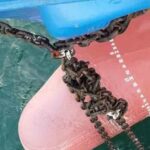Real Life Accident: Crew Member Loses His Life In Fuel Tank
A crew member lost his life while working in a fuel oil tank at a time when the ship was undergoing repairs in dry dock.
The tank had been prepared for entry on the previous day and was tested and passed by the chief officer and shipyard chemist prior to entry for inspection. An appropriate enclosed space entry permit was issued.
After the inspection of the tank had been completed by the shipyard and company representatives, the ship’s bosun was instructed to secure the tank lid. The chief officer also instructed him to renew the gaskets of the manhole cover. In order to facilitate proper tightening of the tank lid with the renewed gasket, the bosun cleaned the contact surfaces of the manhole and lid.
As a result, some debris had collected on the upper access ladder platform located immediately underneath the manhole, approximately two metres below the deck. The bosun sent an ordinary seaman (OS) to collect the debris; he descended to the platform and requested for a brush and dustpan to be lowered in order to sweep the platform clean. The enclosed space was safe for entry, having been visited only 30 minutes earlier by the inspection team.
While an able seaman (AB) was sent to fetch the cleaning gear, the bosun observed that the OS inside the tank appeared to be kneeling, but assumed that this pose was to facilitate better cleaning of the platform. A few minutes later, the bosun called out to the OS and lowered the cleaning gear on a rope. The OS rose from the kneeling position, with his hands extended above his head in order to collect the equipment being lowered. At this point he either suffered a black out or just lost balance and fell backwards 12 m down to the tank bottom from the platform. The platform was only provided with guard rails on two of its sides, and the unprotected side happened to be the one behind the OS.

An emergency alarm was immediately raised and the chief officer, bosun and the AB entered the tank wearing breathing apparatus. At the same time, the master informed the emergency services via the yard foreman. The shipyard rescue team arrived promptly and joined the ship’s team in the tank. The OS was brought on to the deck, but regrettably was pronounced dead by the doctor.
The OS had joined the vessel as a messman and after three months onboard, on his own request, his rank was changed to OS. However, later detailed study of his appraisal reports by two previous masters revealed some discrepancies, which were not properly reviewed by the management before granting the OS’s request.
The ship’s enclosed space entry log revealed that the OS already had some 14 hours’ previous experience of working in enclosed spaces, mainly working in void spaces and cargo tanks. The record of hours of rest for the OS revealed that he was not overworked or otherwise suffered from fatigue.
The autopsy report stated external and internal injuries as the cause of death and confirmed that the fall was not as a result of asphyxiation, alcohol or drugs. Tank atmospheric checks immediately after the accident showed that there was sufficient oxygen in the space.
Root cause/contributory factors
- The upper platform on the access ladder had safety railings only on two sides, with no guard rails or chains on the tank side. This design flaw seems to have existed from the time of construction of the ship and apparently had not been rectified;
- Although the tank entry permit was still valid, the Code of Safe Working Practices requires a fresh risk assessment and a new permit whenever there is a change in the proposed task or the personnel involved. In this case, the bosun made a hasty decision to send the OS into the tank on a seemingly simple and quick task, without going through the proper risk assessment process;
- Probable momentary ‘black out’ when the OS stood up from kneeling position;
- Lack of safety harness with lifeline;
The OS, although properly attired, did not have an oxygen meter with him while working inside the tank. Although this was in breach of the company requirements, it did not in any way contribute towards the accident.
Recommendations
Suitable securing arrangements should be put in place around the platform before the vessel departs dry dock. Such arrangements to be also put in place in similar locations on the vessel.
Tanks/spaces on other company vessels to be checked at a suitable opportunity to ensure proper safeguards are provided.
Format/contents of the company’s enclosed space permit to be reviewed and amended to expand the scope of risks associated with the entry/work to be performed. Until the issue of the amended enclosed space permits, all enclosed space entries should be accompanied by a risk assessment.
Reference: nautinst
Image Credits: usgs
Do you have info to share with us ? Suggest a correction
- Real Life Incident: Vessel Collision in Good Visibility
- Real Life Incident: Severe Injury To Deck Crew While Leaving Berth
- Real Life Incident: Departure Damage in Very Restricted Waterway
- Real Life Incident: Low Situational Awareness Has High Impact Consequence
- Real Life Incident: Fouled Anchor in a Designated Anchorage
- Real Life Incident: Fire On Barge Carrying Scrap Metal Causes $7 Million Worth Of Damage
Latest Case studies Articles You Would Like:
Subscribe To Our Newsletters
By subscribing, you agree to our Privacy Policy and may receive occasional deal communications; you can unsubscribe anytime.
Web Stories






















It must have a continuous running of air blower supply to fuel oil tank.. And safety harness while working to the worker in enclosed space..